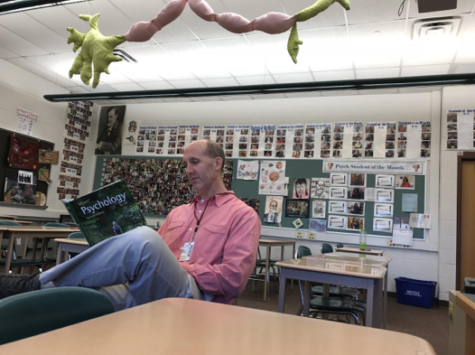Textbooks, Computers, iPads Coexist in HHS Classrooms
March 13, 2018
Recent school-wide changes may seem sudden. In reality, they are planned years in advance.
The rise of new classes is leading to different methods of learning. New curriculums are made to accommodate novel course purposes, but the fundamental use of textbooks has not changed. As Hershey High School teachers work proactively to adapt their classes, old and new teaching tools are used.
One subject that may be difficult to learn without textbooks is mathematics. According to HHS math teacher Emily Bancroft, although the use of books is changing, they still aid in teaching fundamentals.
Bancroft’s textbook use differs in her classes of Algebra I, Algebra II Trigonometry, and Intro to Programming with Visual Basic. The Algebra II Trig textbook is used heavily, while Algebra I textbooks are used just as supplements. In these classes, Bancroft emphasizes using and giving alternate resources to teach and learn.
A typical day of algebra class consists of completing a warm up, learning new content, and practicing. Instead of strictly following a textbook, Bancroft enjoys utilizing IXL, an organization self-described as “an immersive K-12 learning experience that provides comprehensive, standards-aligned content.” Bancroft grades homework and online work for completion; she prioritizes practice before performance.
In her non-math class, Visual Basic, the accompanying textbook is used less due to the nature of the course. Its focus is to teach computer skills, but there are constant advancements to computers.
“The textbook is constantly evolving,” Bancroft said.
She wants student to learn from application and opportunities to take initiative in order to foster problem solving skills, which are a necessary trait while working with technology.
Similarly to Visual Basic, the journalism electives are focused more on learning by application than by textbook. Robert Sterner, advisor of the HHS Broadcaster, has never used an official textbook for students to for Journalism I, II, III, or IV. However, he uses many Journalism books and textbooks to develop guidelines.
One such book is “Inside Reporting” by Tim Harrower. Students do not have required interaction with it, but it and other textbooks provide helpful terminology and elements of writing as a supplement to his personal teachings. Sterner believes electives allow enjoyable flexibility, and classes with the same objectives can meet them with different teaching methods.
“Working without a textbook can free up a teacher,” Sterner said.
The idea for a Journalism IV course came in 2012 from Sterner and two other Journalism teachers, Mr. Gessel and Mrs. Brown. Although unsure of its daily teachings, Sterner visualized a greater focus on videography and a distinction from broadcast reporting found through the school newspaper.
Sterner tries to improve the journalism program every year, and he doesn’t want regimented daily work. To better understand the journalism process, he has written stories alongside reporters and experienced firsthand the positives and negatives. To Sterner, college does not prepare teachers for every scenario.
“Sometimes you have to do the project alongside the kids,” Sterner said.
Sterner worked with DTSD’s Director of Instructional Technology, Traci Landry, on the class budget, justifying needs for equipment such as cameras, iMac computers, and laptops. Although other school districts may hire certain individuals to decide the budget or choose a curriculum, Derry Township allows teacher input to hold influence.
Every winter, new budgets for the next school year must be submitted well in advance. Sterner plans to help J4 students stream video directly online through a platform such as YouTube, which may require new cameras and other technology. Additionally, he is considering J4 as a blended course to promote a teamwork aspect among old and new members.
Like Sterner, HHS teacher Pete Steelman has begun to teach a novel course recently: AP Psychology. In its second year at HHS, this class has about a 60% overlap with the regular psychology curriculum. Therefore, the type of textbooks and the frequency of use differs.
According to Steelman, approval of a new curriculum is a process involving a review board that considers benefits and drawbacks, a budget, and textbook choices. He sees no downsides to having a textbook for psychology classes.
“It’s reference and a guideline,” Steelman said.
Regardless of classes’ blended status, technology use, or textbook use, every decision is thorough and made to have a positive impact on modern learning.








